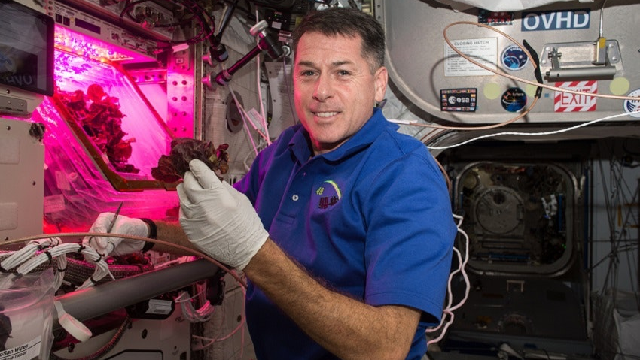Astronauts report the plants are fresh, nutritious and safe to eat.
This interesting article is suited to students in years 2, 4, 5, 6, 7, 9, and 10 studying Biological, Earth and Space or Physical Sciences. It demonstrates some amazing research happening in space right now that uses knowledge from the curriculum such as ecosystem stability and gravity to positively impact future astronauts.
Word Count: 510
Astronauts may no longer have to miss out on eating freshly picked, gourmet salad. Researchers have successfully grown lettuce that is nutritious and safe to eat on a space station.
This is welcome news for the space voyagers, who subsist on processed, pre-packaged rations that have been sterilised through heating, freeze drying or irradiation such as fruits, nuts, chocolate, shrimp cocktails, peanut butter and beef.
While these foods are quite diverse, the quality and nutrients degrade over time, says researcher Christina Khodadad from Kennedy Space Centre, and NASA has long sought to grow fresh food to supplement astronaut’s diets.
Not only can plants provide additional variety and nutrients lacking in pre-packaged food, such as potassium and vitamins K, B1 and C, Khodadad says they could deliver psychological benefits for the crew and help recycle the air by taking up carbon dioxide and generating oxygen.
But the biggest challenge growing plants in microgravity is watering them.
“In the absence of gravity there is no natural convection, and water and air do not mix well in the plant root zone,” she explains. “Plant roots need water but they also need oxygen, and in microgravity there are often cases of insufficient or excess water to crops.”
High radiation is another challenge, being problematic for food safety and a healthy human-plant-microbial ecosystem when voyaging out of the Earth’s protective magnetic field for long periods.
As detailed in the journal Frontiers in Plant Science, Khodadad and a multidisciplinary team led by Gioia Massa conducted experiments growing red romaine lettuce (Lactuca sativa cv ‘Outredgeous’) on the International Space Station and on the ground in “Veggie” production systems.
These are growth chambers containing LED lighting and a watering system especially designed to grow crops in space. Conditions were monitored by logging temperature, carbon dioxide and humidity data and replicating them in their Earth laboratory.
The crops were grown in stages for one to two months, and once tests showed they were safe to eat, the astronauts got to eat half of them while the other half were frozen and returned to Earth for nutrient, food safety and microbial analysis.
They found no significant differences in nutrient content – and in some trials, space-grown lettuces tended to be richer in elements such as potassium, sodium, phosphorous, sulfur and zinc, as well as phytonutrients with anti-inflammatory, anti-viral and antioxidant properties.
The diversity of microbes was also similar for space- and Earth-grown lettuce; no human pathogens such as coliform E. coli, Salmonella sp. or S. aureus were detected and the numbers of fungal and mould spores were safe for human consumption.
Encouraged by these findings, the team will continue to test leafy crops and start growing small fruit crops such as peppers and dwarf tomatoes.
Khodadad says they are also learning lessons about how to water and grow plants in space that can inform the design of future space crop production systems.
Login or Sign up for FREE to download a copy of the full teacher resource






